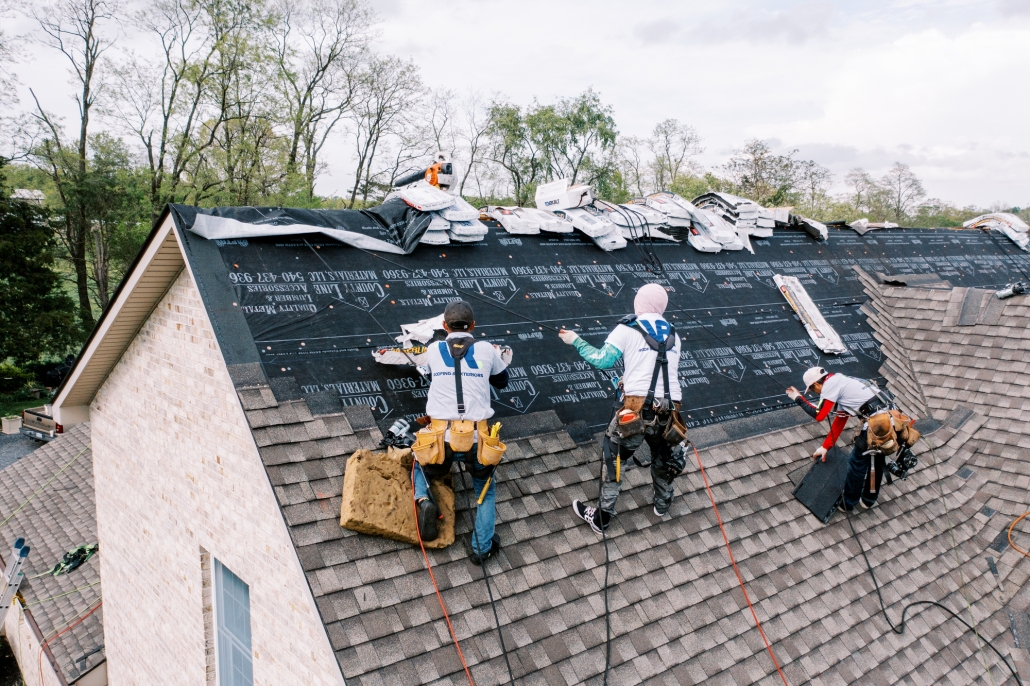Essential Inquiries to Ask Gainesville Roofing Companies Prior To Hiring
Essential Inquiries to Ask Gainesville Roofing Companies Prior To Hiring
Blog Article
Finest Practices for Ensuring Proper Roof Covering Air Flow
Ensuring appropriate roofing air flow is important for the durability and efficiency of a roof covering system. A well balanced consumption and exhaust air vent ratio, typically 1:300, plays a critical function, with consumption vents ideally positioned at the lower edge of the roof for awesome air access and exhaust vents at the peak for cozy air leave. Regular inspections to identify blockages and preserve clear air flow are extremely important. Moreover, maintaining insulation far from vents is vital to stop air movement restriction. Understanding these foundational elements sets the stage for even more comprehensive insights right into installation and upkeep practices that can significantly enhance your roof system's efficiency.
Understand Air Flow Fundamentals
Properly comprehending air flow fundamentals is vital for making sure the durability and performance of roof systems. Effective air flow minimizes moisture accumulation and temperature level extremes in the attic, both of which can result in substantial structural damages in time. A well-ventilated roof helps in avoiding common issues such as mold and mildew development, timber rot, and ice dams, which can compromise the integrity of the roofing materials and the underlying frameworks.
The main objective of air flow is to promote the activity of air, enabling a regular exchange between the interior and exterior environments. This equilibrium is accomplished with a combination of consumption and exhaust vents that function together to keep ideal air flow. Intake vents, generally situated along the eaves or soffits, allow fresh air to go into the attic space, while exhaust vents, frequently situated at or near the roof ridge, make it possible for warm, humid air to escape.
Trick variables influencing the performance of roofing system ventilation include correct placement, ample sizing, and ensuring that both consumption and exhaust vents are unhampered. Regular inspection and upkeep are important to recognize prospective obstructions, damage, or ineffectiveness in the ventilation system, therefore safeguarding the roofing system's efficiency and resilience.
Kinds Of Roof Covering Vents
Roofing vents play an essential function in maintaining reliable attic room ventilation and, by expansion, the overall health and wellness of the roof. Different sorts of roofing vents are available, each with special advantages tailored to specific roofing demands. Ridge vents, as an example, are mounted along the roof's height, enabling cozy, damp air to get away from the attic. They use continual air flow and blend perfectly with the roofline, making them both efficient and cosmetically pleasing.

Soffit vents are set up under the eaves and work in tandem with roofing system vents to make certain a well balanced intake and exhaust system. By enabling cooler air to get in from below, soffit vents promote the expulsion of hot air through top vents. Gable vents, located on the exterior wall surfaces of the attic room, offer another efficient option, specifically in homes with saddleback roofs.
Evaluate Your Existing Ventilation

Following, consider the age and problem of your roof covering products and air flow elements. Older systems might not abide with existing structure codes or may have worn away over time, lowering their effectiveness. Conduct a detailed evaluation to identify any kind of indications of damage, such as rust, damages, or gaps that could endanger the system's performance.
In addition, measure the attic temperature and moisture levels. High temperatures and humidity can indicate insufficient air flow.
Installation Best Practices
Reliable installation of roof ventilation systems is paramount for guaranteeing optimal efficiency and durability. Appropriate installment begins with comprehending the certain air flow requirements of the structure and the roof covering it covers. This entails determining the right ratio of consumption to exhaust vents, usually adhering to the 1:300 guideline, which stipulates one square foot of ventilation for every single 300 square feet of attic flooring room.

Consumption vents should be set up at the roofing's lower edge, often in the soffits, to allow awesome air to get in. Exhaust vents, on the other hand, must be mounted near or at the that site roofing's peak to help with the leave of warm, wet air.
Seal all air vent links diligently to avoid air leakages and possible water seepage. Use top notch products and follow manufacturer guidelines to make sure durability and efficiency. Additionally, integrating ridge vents with baffles can considerably boost airflow performance by preventing wind-driven rain and snow from entering the attic room.
Inevitably, specific setup of roof covering air flow systems alleviates prospective problems such as mold development, ice dams, and architectural damages, ensuring the roof covering's honesty and the structure's total health.
Routine Maintenance Tips
Uniformity in maintenance methods is basic to making certain the lasting effectiveness of roofing air flow systems. Normal inspections are important, preferably done biannually-- in the spring and autumn. Throughout these examinations, make certain that vents are without debris, nests, and various other blockages that could hamper airflow. Examine for any type of signs of moisture build-up or mold, as these can show incorrect ventilation or leaks (roofing companies gainesville florida).
Cleaning the vents is another vital job. Utilize a soft brush or a vacuum to eliminate dust and particles from intake and exhaust vents. Beware not to harm the air vent screens or louvers during the procedure. Furthermore, examine the attic room for any kind of indicators of water damage, which might endanger the stability of the roof.
Correct insulation is just as essential. Guarantee that attic insulation does not obstruct the vents, as this can drastically limit air movement. Rearrange or change it to preserve an effective obstacle. if any insulation has actually changed or resolved.
Last but not least, replace you could look here any type of harmed or missing out on components promptly. Broken vents, cracked roof shingles, or tatty blinking can all add to poor air flow and ought to be resolved immediately. Normal maintenance makes certain that the roof ventilation system functions optimally, thus expanding the lifespan of the roof itself.
Final Thought
Making sure appropriate roofing air flow is paramount for keeping the performance and toughness of a roof covering system. Adherence to the 1:300 intake and exhaust air vent ratio, combined with the tactical placement of vents, is vital. Regular semiannual inspections, particles cleaning, and guaranteeing insulation does not obstruct airflow are crucial techniques. Carrying out these ideal techniques will cultivate a well-ventilated roof system, thereby reducing possible problems connected to moisture build-up and too much warmth, inevitably extending the roof covering's life-span.
A well balanced intake and exhaust air vent proportion, typically 1:300, plays a crucial duty, with consumption vents ideally placed at the reduced edge of the roof covering for amazing air entry and exhaust vents at the optimal for warm air exit. Consumption vents, generally situated along the soffits or eaves, allow fresh air to go into the attic room space, while exhaust vents, often situated at or near the roof ridge, allow hot, damp air to leave.
Soffit vents are set up under the eaves and work in tandem with roof covering vents to make sure a well balanced consumption and exhaust system. By allowing cooler air to get in from below, soffit vents facilitate the expulsion of warm air via upper vents. Adherence to the 1:300 consumption and exhaust vent proportion, paired with the strategic placement of vents, is crucial.
Report this page